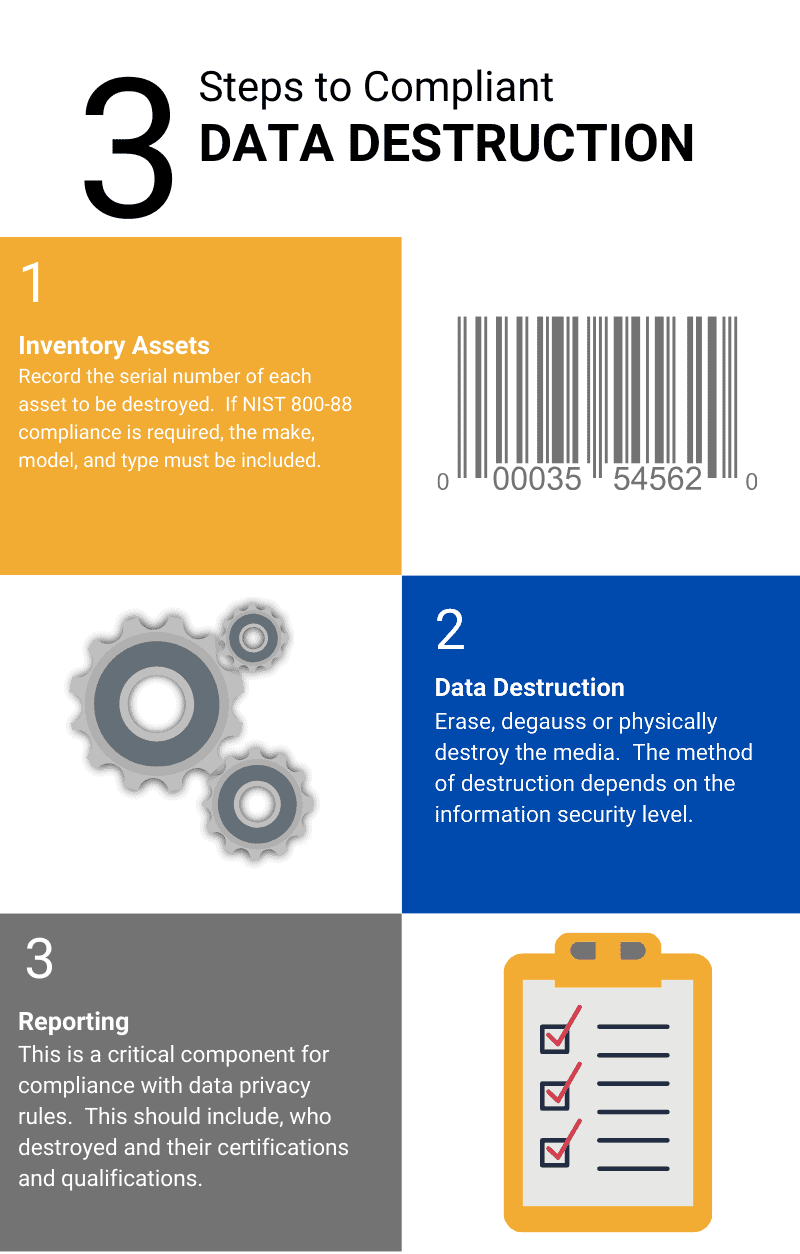The Effect of Effective Data Destruction on Cyber Security Danger Administration
The Effect of Effective Data Destruction on Cyber Security Danger Administration
Blog Article
Checking Out the Value of Information Destruction in the Context of Computer Security Services and Protecting Confidential Data
In an era where information breaches are significantly typical, the importance of reliable data damage can not be overemphasized. What strategies can organizations implement to improve their information destruction protocols?
Comprehending Information Destruction
Information devastation is a vital part of computer system safety that entails the long-term removal of information from storage space devices to avoid unauthorized accessibility and prospective information violations. In an increasingly digital landscape, companies face increased dangers related to delicate information being improperly accessed or manipulated. Reliable information devastation safeguards versus these threats, guaranteeing that confidential dataâEUR" such as client info, intellectual building, and monetary recordsâEUR" can not be recovered after disposal.
Understanding the relevance of information destruction prolongs past simple conformity with regulative and legal frameworks; it is necessary for keeping business stability and depend on. When information is incorrectly managed or inadequately destroyed, the effects can be extreme, consisting of monetary loss, reputational damage, and legal liabilities.

Methods of Information Eradication

One prevalent technique is information cleaning, which entails overwriting existing information with arbitrary patterns numerous times. This technique renders the original data irretrievable, making it a prominent option for organizations seeking to secure personal details.
Another method is degaussing, which uses a powerful electromagnetic field to interrupt the magnetic domains on storage devices, properly eliminating the data. This technique is specifically reliable for magnetic media however is not suitable to solid-state drives.
Physical damage is one more robust approach, crushing or including the shredding of storage devices. This method warranties that information recuperation is essentially impossible, making it optimal for extremely delicate information.
Lastly, security can work as a corresponding strategy to information removal. By encrypting information before deletion, companies can include an added layer of protection, making sure that even if residues are recouped, they stay unattainable without the decryption secret. Each method needs to be selected based upon the degree of data level of sensitivity and the certain safety requirements of the company.
Legal Compliance and Information Safety
Organizations need to navigate a complex landscape of lawful demands associated with information safety and security, specifically after applying approaches of data eradication. Different regulations, such as the General Information Security Law (GDPR) and the Health And Wellness Insurance Coverage Portability and Responsibility Act (HIPAA), impose rigorous standards on just how organizations have to get rid of and deal with of delicate information. Failure to follow these regulations can cause substantial legal effects, including considerable penalties and reputational damages.
Information destruction procedures should be diligently documented to demonstrate compliance with suitable regulations and requirements. This documentation not only works as evidence of adherence to lawful commitments but also highlights a dedication to safeguarding sensitive info. Organizations must additionally develop clear plans relating to information retention and devastation timelines, ensuring that data is not held longer than necessary.

Furthermore, routine audits and evaluations of data damage practices are important to maintain compliance and adapt to advancing legal structures (data destruction). By proactively attending to legal requirements, companies can minimize dangers connected with data breaches and show their commitment to data security. Inevitably, prioritizing lawful conformity in data destruction procedures is not just a regulative responsibility, yet a fundamental facet of a durable data security method
Influence On Business Reputation
The online reputation of a service can be considerably impacted by its strategy to data damage and management. In today's electronic landscape, where data violations can occur at any kind of moment, the failing to effectively dispose of delicate information can cause see this severe effects. Organizations that inadequately handle data devastation risk revealing confidential client details, which not only goes against privacy regulations however additionally erodes depend on amongst stakeholders and customers.
A damaged track record can cause decreased consumer commitment, as clients come to be reluctant to engage with a company that has actually shown carelessness in shielding their data. Negative publicity surrounding a data violation can have a long-term effect, as prospective clients may be hindered by the regarded absence of security. This can result in a direct decline in profits and market share.
Moreover, businesses that prioritize data destruction as part of their safety and security technique can improve their track record by showcasing their dedication to securing delicate info. By embracing rigorous data administration methods, companies can not just minimize risks however also position themselves as trustworthy entities in their respective sectors, therefore reinforcing their overall brand image.

Ideal Practices for Secure Disposal
Carrying out finest practices for protected disposal of information is important for mitigating threats related to data breaches and ensuring compliance with personal privacy policies. Organizations should take on a detailed data disposal plan that outlines treatments for both physical and digital data devastation.
For physical data storage space gadgets, such as disk drives, shredding or degaussing is advised to stop data healing. Additionally, companies should preserve a chain of protection documents during the disposal process, guaranteeing responsibility and traceability of disposed things.
For digital information, making use of software application that complies with industry requirements for information cleaning is important. This software program ought to overwrite existing information numerous times, making healing virtually impossible. It is likewise vital to verify the efficiency of the information destruction procedure via audits or third-party assessments.
Training staff members on safe and secure disposal practices adds an additional layer of security, as human error can usually lead to data exposure. Consistently reviewing and updating disposal plans guarantees positioning with advancing regulations and technological developments. By carrying out these finest techniques, organizations can dramatically decrease the risk of unauthorized data gain access to and improve their general data security strategy.
Conclusion
Finally, data damage is a basic element of computer system protection solutions that ensures the security of secret information from unapproved gain access to. Applying effective approaches of information elimination, adhering to legal compliance, and recognizing Recommended Reading the impact on organization reputation are essential parts of a comprehensive data protection approach. By embracing finest practices for safe and secure disposal, companies can foster depend on with clients and protect delicate information, ultimately adding to a much more protected digital landscape.
In an age where information violations are increasingly usual, the relevance of efficient data damage can not be overstated.Information devastation is an important element of computer protection that includes the permanent removal of information from storage tools to stop unapproved gain access to and potential data breaches. Organizations should additionally develop go to my blog clear policies pertaining to data retention and devastation timelines, guaranteeing that information is not held longer than needed.
By proactively attending to legal needs, organizations can minimize risks connected with information breaches and show their dedication to data security (data destruction). Eventually, focusing on legal compliance in information devastation processes is not just a governing responsibility, yet a fundamental element of a durable information safety and security method
Report this page